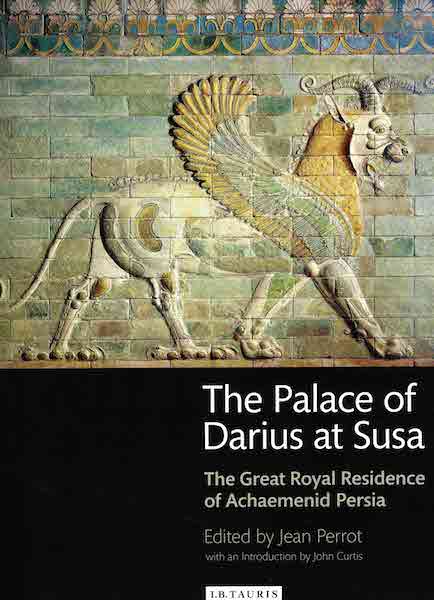The Palace of Darius at Susa: The Great Royal Residence of Achaemenid Persia

he palace complex of the Persian King Darius I, the Great (522-486 BCE), provides unique evidence of the sophistication of Achaemenid architecture and construction. This palace, built 2500 years ago in western Iran, lay at the centre of the Persian Empire that stretched from the Nile and the Aegean to the Indus Valley. First rediscovered in 1851, the Palace of Darius was partly excavated over the next century but it was only field research between 1969 and 1979 by the noted French archaeologist Jean Perrot which revealed the site’s full dimension and complexity. Its bull-headed capitals, enamel friezes of richly-clad archers holding spears, figures of noble lions and winged monsters, introduced a new iconography into the ancient Persian world. The discovery and excavation of the palace, which this book records, thus casts a new light on the beginnings of the Achaemenid period. Edited by the distinguished scholar of ancient Persia, John Curtis, the lavishly illustrated volume is a work of seminal importance for the understanding of ancient Persia, likely to be radically altered by Perrot’s research and findings.

A former Director of the Centre National de la Recherche Scientifique (CNRS), Dr Jean Perrot (1920-2012) is an archaeologist and scholar who led the Délégation Archéologique Française en Iran (DAFI) which made many important Achaemenid discoveries in Iran between 1968 and 1979. Perrot was a graduate of the Ecole du Louvre where he studied under two experts in Syrian archaeology – André Parrot and René Dussaud. He went on to study at the École Biblique et Archéologique Française de Jérusalem in 1945. He researched a number of ancient sites in Iran, Israel and Turkey, animating the research at international level. He first went to Iran in 1968, a year after the retirement of Roman Ghirshman, to head the Delegation Archéologique Français (DAFI) and excavations of the country’s ancient sites. He headed a multidisciplinary team in conjunction with the Iranian Centre of Archaeological Research, including experts from France, Iran and the United States who continued studies until the revolution in 1979. He worked on sites such as Susa and Jafar Abad and took measures to safeguard the vestiges of the Achaemenid period (between the sixth and fourth millennia BC). His notable discoveries included the headless statue of Darius which is now housed in the National Museum of Iran in Tehran.
‘King Darius’ Palace at Susa is perhaps the least well known yet the most important of the Achaemenid Persian palaces, less perhaps for its remains on the ground than for its architecture and treasures which are to be seen in Teheran and notably in the Louvre. French exploration of Susa, which began in 1885/6, continues. This magisterial volume, the translation of the French edition of 2010, brings together at last a comprehensive account of the architectural remains and the finds, from various scholarly hands. It is a major resource and, with its lavish illustration, a joy to handle and read.’
Sir John Boardman, FBA, Emeritus Lincoln Professor of Classical Art and Archaeology, University of Oxford
‘This lavishly illustrated volume on Darius I’s palace at Susa is not only of utmost importance for the specialist in Near Eastern Archaeology. With its chapters on the history of Elam in Achaemenid times, and on the royal builder himself, it is also an indispensable tool for historians of Pre-Islamic Persia. Its comprehensive account of the French excavations provides key insights into European encounters with Iran as well into the history of scholarship.’
Josef Wiesehöfer, Professor of Ancient History, Kiel University
‘This sumptuous volume provides a richly illustrated, authoritative survey of the key structures and many individual objects found at Susa that can be said to have contributed so much to the advancement of Achaemenid studies, beginning in the second half of the nineteenth century. Above all, students of the evolution of early Achaemenid art and architecture will find this multi-authored volume to be essential reading.’
David Stronach, OBE, Professor Emeritus of Near Eastern Archaeology, University of California, Berkeley
The Persian Empire achieved its greatest glory under Darius, a king who crowned his achievements by building magnificent palaces at Persepolis and Susa. This lavishly illustrated new book looks at Susa, which sat at the centre of the Achaemenid Empire during the 5th and 4th centuries BC. The wonderful photographs and maps by archaeologists past and present, the delicate watercolours painted by early visitors, and the detailed plans and diagrams explaining layout, architecture, and building techniques ensure it is a joy to look at, as well as to read. Not only easy on the eye, this huge tome both reveals the history of the archaeology of the site from its identification in the 19th century, and discusses the findings of subsequent investigation and recent excavation. Throughout, we are treated to a comprehensive history of the Empire from its earliest days in the 6th century BC, and insights into life and rituals during these fascinating times. An informative introduction written by the British Museum’s John Curtis includes an affectionate tribute to the editor – and excavator – Jean Perrot, who, sadly, died before seeing his work published. The book will appeal to readers on several levels: the armchair traveller, the enthusiastic amateur, and the informed scholar.
Current World Archaeology Journal
CONTENTS
Introduction
Dr John Curtis
Foreword
List of Events in the Achaemenid Period
Genealogical Table of the Achaemenid Dynasty
Susa and Elam in the Achaemenid Empire
Darius: The Great King
The Discoverers of the Palace of Susa
The Franco-Iranian Programme (1969-1979)
The Geophysical Survey of the Achaemenid Foundations
The Archaeological Data
Restoration, Reconstruction
The Egyptian Statue of Darius
The Main Achaemenid Inscriptions of Susa
The Fired Arts
Decorative Arts at Susa during the Persian Period
Other Works of Darius and his Successors
The Susa and Iranian and Middle-Eastern Architecture
Darius in his Time
Appendix: The Inscriptions of Darius at Bisitun

